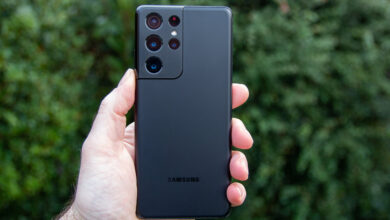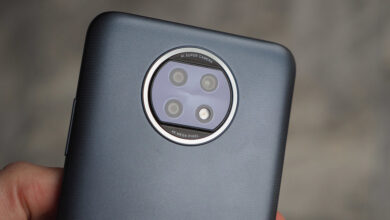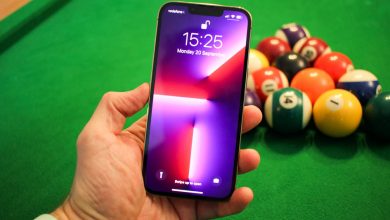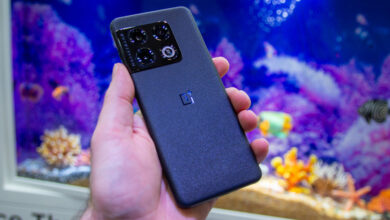Google Pixel 6 Pro initial review: A proper flagship phone
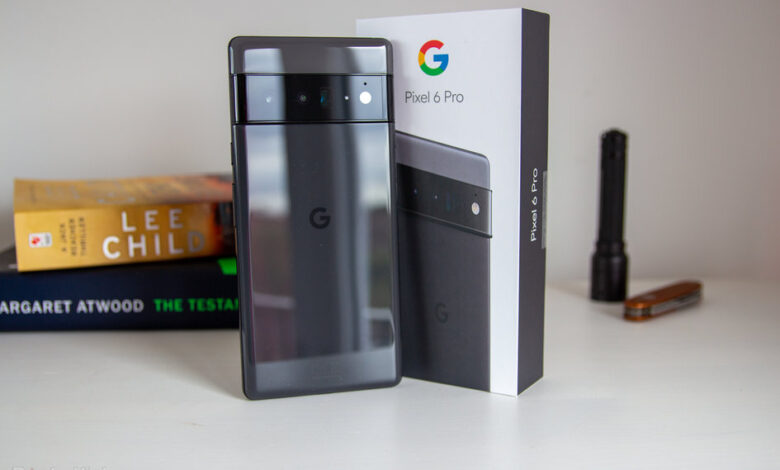
[ad_1]
(Pocket-lint) – If Google’s Pixel line of phones appeared to stumble in 2020, then 2021 is all about coming back stronger.
The Pixel 5 launched as a mid-range device, seemingly stepping away from flagship ambitions and, while it offered some interesting elements, to many it felt as though it lacked ambition. It was, ironically, the perfect phone for 2020.
With refreshed enthusiasm in the air for 2021, we have the Pixel 6, and a new flagship, the Pixel 6 Pro. And it feels like Google’s most ambitious phone yet.
Design and build
- Dimensions: 163.9 x 75.9 x 8.9mm / Weight: 210g
- Alloy frame, Gorilla Glass Victus
- IP68
The Pixel 6 Pro is similar is size and weight to the Samsung Galaxy S21 Ultra, and carries with it many of the hallmarks of premium smartphone design.
It steps up over the Pixel 6 with a “waterfall” display, curving over the edges, matched with the curving of the glass of the rear panel. An alloy unibody runs through the centre of the phone, emerging with a polished finished around the edges, while also framing that camera array on the rear.
It’s the back of the phone that people have been talking about and rightly so. When Google launched the Pixel 4 with its camera square on the rear it was designed to stand out. On the Pixel 6, the camera is the design.
There’s a retro feel to it – especially with some of the colours being offered – and long gone are the days where we saw the likes of Huawei’s CEO Richard Yu crying “no bump!” from the stage; the Pixel 6 Pro is manifestly bump.

The quality of the finish is great, save for one minor detail: the camera array, sitting between the metal bands of the frame, is actually three sections – the centre and the curved parts on either end. That means there are two seams in this section which we wish weren’t there.
Moving on there’s IP68 protection, flagship grade waterproofing, while the glass front and back is Gorilla Glass Victus, the best that Corning offers.
Within the design there are stereo speakers, with a long slit across the top of the display where it meets the frame and an orifice on the bottom of the phone. There’s no 3.5mm headphone socket.
Display
- 6.7in LTPO OLED, 19.5:9
- 3120 x 1440 pixels, 512ppi
- 120Hz (adaptive), HDR
There’s a large 6.7-inch display on the Pixel 6 Pro, with the Pixel 6 coming in smaller at 6.4-inches. The Pro model also differs from the regular with a Quad HD+ resolution, that’s 3120 x 1440 pixels, for a pixel density of 512ppi.
That’s the same size as the iPhone 13 Pro Max, but a little higher in resolution.

This is an LTPO OLED display, meaning it can offer adaptive refresh rates. That will see the display actively switching to suit the content it’s displaying, with a range from 10-120Hz. The idea is that static content, like an ebook, would be at 10Hz so you’re not wasting battery refreshing to page, while fast scrolling can happen at 120Hz to reduce tearing and make it appear smoother.
You can, if you wish, turn it off and stick to 60Hz refresh instead.

There’s a punch hole to the top of the display for the front camera, while Google has also moved over to offering an under-display fingerprint scanner on the Pixel 6 models. That keeps the rest of the design clean – and while we never had a problem with fingerprint scanners on the rear, certainly, many will welcome its new position on the front.
Hardware
- Google Tensor 5G, 12GB RAM
- 128/256GB storage
- 5003mAh battery, 30W wired, 23W wireless charging
Where the Pixel 6 Pro makes a departure from many other devices on the market is in its hardware. Sitting at the core of the phone is Google Tensor, Google’s own design of system on chip.
Google claims that that the phone is up to 80 per cent faster than the Pixel 5, although that was on mid-range Snapdragon 765G hardware – and we really don’t know what Google bases these comparisons on. Having used both phones, yes, the Pixel 6 Pro does feel smoother and faster – and every inch the flagship experience. Google says this hardware has been 4 years in the making and a large part of what Tensor wants to do is boost the artificial intelligence and machine learning of devices – and allow that to run on the phone rather than in the cloud, making it faster and more secure.

In the time we’ve been using the Pixel 6 Pro we haven’t encountered any problems, but we’ll be able to fully flesh out the experience in our full review in the near future.
Google Tensor supports 5G and there will be a number of different versions of this phone – a Sub 6 model, and versions that include mmWave too. There’s also Wi-Fi 6E support and Bluetooth 5.2 – as well as ultra-wideband (UWB).
Google details that the UWB functionality isn’t enabled at launch and without anything to test it with, that probably doesn’t matter – but we’re expecting the likes of Tile Ultra in 2022 and compatibility with cars like the BMW iX in the future too.
There’s no microSD – something that Google shuns perennially – while 128 and 256GB options provide the storage.
There’s a single USB-C on the bottom of the phone, allowing charging of the 5003mAh battery at speeds up to 30W, although there’s no charger in the box, just a cable. That means you’ll have to provide your own charger.

It’s not the fastest charging around at 30W (and it’s designed for a USB-PD 3.0 PPS charger) but that’s still speedy and will keep most users happy. On the wireless charging front there is support up to 23W, but only using the Google Pixel Stand (2nd gen) according to Google. It will also support 12W wireless charging from a Qi wireless charger.
Google is claiming that you’ll get 48 hours of use from the Pixel 6 Pro or 48 hours if you use the extreme power saving mode, although the latter restricts what you can do with your phone, disabling a lot of the apps. As the name suggests, it’s an extreme choice.
We’ll be able to report in more detail on the performance and the battery life of the Pixel 6 Pro in our full review once we’ve had longer to evaluate the phone fully.
Cameras
- Triple rear camera array:
- Main: 50MP, 1/1.31in, 1.2μm, f/1.85, OIS
- Telephoto: 48MP, 1/2in, 0.8μm, f/3.5, OIS
- Ultrawide: 12MP, 1.25μm, f/2.2
- Front: 11.1MP, 1.22μm, f/2.2
There’s a completely new camera system in the Pixel 6 Pro, pairing up a higher resolution main, a folded type (periscope) telephoto and an ultrawide. This is one of the areas that this phone differs from the smaller Pixel 6 which misses out on the telephoto.
While the composition of the cameras has changed, much of the look and feel of the Pixel camera is much the same. There are new features, but Google is still taking the approach of making this an easy camera to use – you point, shoot and get the results regardless of the conditions.

As such, it leans on AI and computational photography, an area where Google has really made a name for itself with the Pixel family.
Although there’s now a 50-megapixel sensor, Google is using pixel binning to result in 12.5-megapixel images, combining four pixels. Like others, Google is claiming a larger surface area to absorb light using this method, something that can feed into supporting low light photography and the famed Night Sight and Astrophotography modes. But unlike others, the Pixel doesn’t let you take huge 50-megapixel photos – or offer a complex overlap of features. It’s all straightforward.
First impressions of this camera system are great – many, many, more details to come with the full review – but the pairing with a proper telephoto lens makes the Pixel much more competitive in the flagship space.

Google talked up its AI cleaning of digital zoom images on previous phones, but now it can offer 4x optical zoom from the folded lens arrangement, and 20x digital zoom beyond that.
There’s a lot more that’s new for the Pixel camera beyond the physical lenses. When it comes to shooting, Motion Mode will let you capture an image and then give the impression of motion in it. That might be a car or cyclist – or any moving object – with the AI figuring out what’s supposed to be moving and what’s not. It can then apply effects to give that sense of speed.
On the editing front, Google Photos gets a couple of options, including Magic Eraser which will remove distracting elements from photos. You can basically highlight to remove things, but there’s also an auto mode that will scan your images and identify things for removal – it’s very clever and means you don’t need to jump into Photoshop to tidy photos up.

Face Unblur attempts to remove the problem of moving faces, restoring them back to some sort of sharpness. Again, it’s Google using AI to figure out what something is supposed to look like and correct it.
There’s also wider support for a diverse range of skin types, so darker skin tones should be recognised and photos kept in balance so people appear as they should.
The great thing is that because many of these are driven by AI, they can be used on existing images. Google Photos will let you use Magic Eraser on older photos, or photos from another phone, for example – and the capture technologies work on the front and the rear cameras. It’s just a smarter way to take photos and the first results we’ve seen have been great.
Software polish
- Android 12
- 4 years of software/5 years of security updates
The Pixel 6 Pro launches with Android 12, with a few unique tweaks that you’ll only get on Pixel. Many phones have been rolling back to offering a cleaner Google experience, but the Pixel is always front of that queue for updates – now with a 4 year version promise, and 5 years for security updates.
The big change is Material You. This is what Google is mostly talking about in Android 12, wanting to make it easy to customise the phone to your preferences. It means you can pick a wallpaper and adapt the phone’s theme to colours related to that wallpaper. You can also switch the icons to be themed to fit in, although that only appears to apply to Google’s own apps and services.

It’s just about as easy as it could be and really effective, allowing sweeping changes through a number of apps to make your device more unique.
There are small changes all over the place, like being able to swipe down the Quick Settings and see the battery percentage change to show you how long it’s actually going to last.
Google also continues to push real-time translation in its devices, with the ability to translate in messaging apps like WhatsApp or in the messaging sections of other apps, like Twitter or Instagram.
Then there’s a boosted focus on privacy, allowing you to see – via a green icon on the display – if your camera or mic is live. You can then tap through to see which apps are using it. Via the Privacy Dashboard you’ll be able to quickly see what is using things like location access and how often, so you can take more control. You can also toggle off the camera or mic if you want to.

There are new options for the home screen – including suggested apps – which will change the icons on your home screen based on what your phone thinks you are about to do. We’ve seen this before in the apps drawer, but now it’s got pride of place on the main page too.
The changes ushered in by Android 12 make the Pixel 6 Pro feel much more like a phone ready to compete with the likes of Samsung. There’s personality to it which hasn’t always been so keenly felt before on Google’s own devices, a refreshing change.
The first impressions of Google’s new Pixel 6 Pro are strong. This feels like a flagship phone from Google, wanting to offer more than just a clever camera.
Of course, the camera is important and from what we’ve seen so far, there’s no let-up in the excellent performance that we’ve come to expect from Pixel.
We’ll be updating with more details on the absolute camera performance, battery life and power in the near future – but from what we’ve seen so far, the Pixel 6 Pro is a phone to be excited about, especially with that asking price.
Writing by Chris Hall. Originally published on .
[ad_2]
Source link



